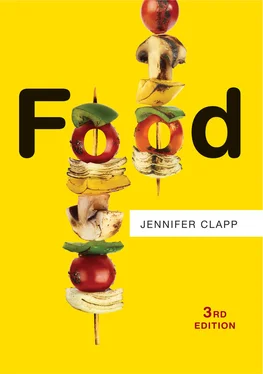That food prices could change so abruptly, and immediately affect access to food for people across the world, was remarkable. The impact of these price spikes were felt most intensely in the world’s poorest countries – countries that had once been agricultural exporters, but which had gradually become net importers of food over the previous fifty years. The poorest members of society in developing countries often spend upwards of 50–80 percent of their income on food. When prices shot sky high, many people’s access to food immediately became severely restricted. The food riots that broke out across the developing world in early 2008 – from Haiti to Egypt to the Philippines – illustrated their frustration. Food prices continued to be high and volatile, with prices reaching new record highs in 2011 and 2012, exacerbated by drought in North America, a major grain-producing region. For those affected by this crisis, particularly young children, the impacts are likely to be lifelong, as even short periods of severe malnutrition in the very young (in the first 1,000 days of life) can have a permanently negative impact on human health, wellbeing, and long-term livelihood potential.
This jarring disruption to the global food system was highly unusual. After all, food prices on world markets had been low and falling for most of the previous thirty years. An earlier sharp spike in food prices occurred in the mid 1970s, but this episode had gradually faded in people’s minds as the problem of low farm incomes persisted for decades. The major concern of the 1980s to early 2000s was with ensuring decent farmer incomes and food security for agricultural producers, especially those in less industrialized countries who, although they produced food, were still net buyers of food and often did not have enough income to secure their own nutrition at adequate levels. To suddenly see such a dramatic new trend of rapidly rising food prices, which so deeply affected many people’s food security, underscores the importance of gaining a better understanding of the way in which the global food system functions and its impact on people around the world. Food prices stabilized somewhat after 2014, but stayed higher than they were before the crisis and the threat of a return to more volatile food prices remains.
More recently, world agricultural markets experienced fresh turmoil in 2018 and 2019, due to growing trade tensions between two of the world’s largest economies – the United States and China. In 2018, US President Donald Trump began to impose tariffs on imports from China, seeking to reduce the US trade deficit with that country. China, which had been importing significant amounts of soybeans from the United States over the past decade, retaliated with its own tariffs against products it imports from the United States, with a particular focus on agricultural goods. As a result, US exports of soybeans plummeted, as did prices for US soybeans on world markets, while China shifted its soy purchases to alternative suppliers – mainly to Brazil and Argentina, which have both been expanding soy production in recent years. Meanwhile, the rapid increase in the spread of the deadly African Swine Fever virus after 2018 resulted in the deaths of a quarter of all pigs globally, including hundreds of millions of pigs in Asia and Europe. The epidemic contributed to an increase in meat prices not seen since 2014 and growing demand for imported meat into affected regions.
These shifts in the global trade of major commodities in the past several years have had not only economic repercussions – in some cases positive, and in some cases negative – for farmers and agricultural traders, but have also been associated with ecological impacts. For example, pressure for further expansion of soy production in South America has been associated with deforestation, climate change, soil exhaustion, and the heavy use of agricultural chemicals. 3
Together, the ecological, economic, and social dynamics of the global food system have profound impacts on both producers and consumers around the world. This book aims to contribute to a fuller understanding of some of the key forces that influence and shape the current global food system. It focuses in particular on the interface between the international political and economic dimensions of the global industrial food system – what I refer to as the “world food economy.” This world food economy is characterized by an increasingly global market for food, with more and more of it traveling through global production, trade, and processing supply chains, influenced by myriad international economic and political forces. Much has been written in recent years on the theme of food systems, particularly on movements that promote alternatives at the local level, as noted above. But the ways in which even alternative food systems are influenced and shaped by the global political and economic forces that have given rise to the dominant global food system are often left unpacked, only partially examined, or are ignored altogether. 4
Yet the international economics and politics of food have significant implications for other scales and dimensions of food systems – from access to food for hungry people in specific locations such as a small, remote village in Africa, Latin America, or Asia; to local sustainable food movements in Europe or North America; to diet-related nutrition and health issues more broadly. Taking a step back to the bigger picture, to look at the wider forces that shape the world food economy and how they reinforce one another, helps to build a richer understanding of these other important dimensions of food systems. While there is always a risk of missing the specificity of the dynamics in particular locations or the impact on certain groups when stepping back to take a global perspective, gaining an understanding of the big picture helps to contextualize the local. Indeed, diverse local level food initiatives that seek to provide alternatives may be difficult to scale up and out precisely because the world food economy creates conditions that push against those efforts. In other words, both place-based local studies and global overviews of broader structural dynamics are needed to gain a comprehensive picture. This book aims to contribute to a deeper understanding of the global political and economic dimensions of food, with the hope that it will complement studies that are grounded in more local case studies or which are more focused on specific issues or groups.
As outlined in the chapters of this book, the expansion of the world food economy did not just emerge on its own overnight. It was shaped by a variety of forces over an extended period of time. Although global food markets emerged well over a century ago, they were given a further push by industrialized countries, and the United States in particular, from the 1940s and 1950s onwards. This phase of expansion in the world food economy saw the promotion of a global adoption of the industrial agricultural model, as well as the development of major international markets for foodstuffs. These developments paved the way for subsequent forces that reinforced the spread of the world food economy in more recent decades. These additional forces include the establishment of new global norms for the liberalization of international agricultural trade; the rise of transnational corporations (TNCs) as dominant agents of global food production, processing, trade, and distribution; and the dramatic increase in the transformation of agricultural commodities, farmland, and agrifood firm shares into financial products bought and sold by investors.
But the expansion of the world food economy is not the entire story. These forces, as they have unfolded, have opened up a greater number of what I call “middle spaces” within that economy, where control and influence over how it operates has become concentrated in the hands of powerful actors who have an interest in seeing that system expand. More intermediaries in the world food economy have become involved in a multitude of activities related to the business of food along expanded food supply chains. It is within these middle spaces of activity where norms, practices, and rules that govern the world food economy are shaped by the very forces and actors that are leading to its expansion. The economic forces and powerful actors that shape the governance systems that guide the expansion of the global food system may seem far removed from the big questions of compensation to agricultural producers; who has access to food in a particular location; and with what effect ecologically and socially. But understanding the influence of global economic forces and the middle spaces they have opened up for powerful intermediaries to set the rules of the game is essential for explaining food outcomes in rich and poor countries alike.
Читать дальше












